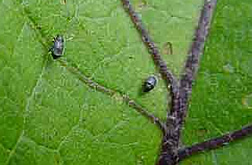This page has been archived and is being provided for reference purposes only. The page is no longer being updated, and therefore, links on the page may be invalid.
|
|
Researchers Decipher Eggplant Pest's Chemical Call
By Jan Suszkiw
October 13, 2006
A rude surprise could be in store for the eggplant flea beetle, bane of commercial growers and home gardeners alike. Agricultural Research Service (ARS) scientists have identified a blend of compounds produced by the pesky leaf eater that could usher in baited traps to lure it to its doom.
The beetle, Epitrix fuscula, is most destructive in the spring, when eggplant seedlings are transplanted from the greenhouse to the field and are less tolerant of defoliation. It also attacks other solanaceous crops, like tomato. Insecticide spraying and cultural practices are the chief means of controlling the pest, which occurs throughout the United States but is most common in the South.
Traps or monitoring stations baited with synthetic versions of its aggregation pheromone—a kind of chemical call to gather for mating and feeding—could help growers better time their spraying, or even reduce their insecticide use, notes ARS entomologist Bruce Zilkowksi. Along with colleagues Bob Bartelt, Allard Cossé and Richard Petroski—all with the ARS National Center for Agricultural Utilization Research (NCAUR) in Peoria, Ill.—Zilkowski will describe the research in an upcoming issue of the Journal of Chemical Ecology.
In host-feeding studies at the center's Crops Bioprotection Research Unit, Zilkowski and research colleagues identified six volatile compounds that male E. fuscula beetles emit while feeding on eggplant leaves. They synthesized the compounds and monitored both male and female beetles' sensory responses using a technique called electro-antennographic detection. The most abundant compounds—(2E,4E,6Z)-2,4,6-nonatrienal and (2E,4E,6E)-2,4,6-nonatrienal—stimulated the greatest electrical response in the test insects' antennae.
In field studies with eggplant at the NCAUR and at an organic farm in spring 2005, traps containing synthetic forms of the two attractive compounds captured 500 percent more male and female beetles than unbaited controls. Zilkowski's team is now trying to fine-tune the ratio of the compounds for maximum performance. They're also examining the compounds' tendency to form isomers, and attempting to determine whether these structurally different variants will help or hinder the development of a commercial pheromone formulation.
ARS is the U.S. Department of Agriculture's chief scientific research agency.


